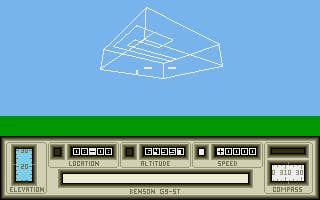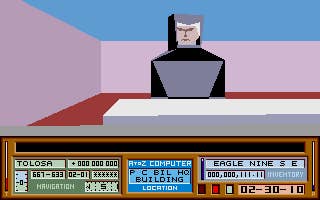Origins of the Open World: Mercenary
We're looking at an impending "year of open world games," but the concept has been around since some innovative games as far back as 1985.
This article first appeared on USgamer, a partner publication of VG247. Some content, such as this article, has been migrated to VG247 for posterity after USgamer's closure - but it has not been edited or further vetted by the VG247 team.
You used to be able to see through 3D polygonal graphics.
This is probably unthinkable to anyone who grew up with video games post-1990, but it's true; the earliest examples of 3D graphics as we know them today were drawn purely using unfilled, untextured wireframes -- a look that tends to be limited to Hollywood trying to look "futuristic" these days.
There were a number of games in the 1980s that made use of these wireframe polygon graphics, the best-known of which were Atari's arcade tank shooter Battlezone, the original Star Wars arcade machine, and David Braben's classic space trading sim Elite.
There was another game that used this distinctive aesthetic that you may be a bit less familiar with, however. A game that quietly set in place a lot of conventions we take for granted in first-person perspective adventure games these days -- particularly those set in an open world. A game that we haven't really seen the likes of since, and which, in a modernized form, wouldn't be altogether out of place in the upcoming "year of the open world" we appear to be just embarking on.
I'm talking about 1985's Mercenary, the work of a British developer known as Novagen Software, headed up by programmer and designer Paul Woakes.

Mercenary casts the player in the role of the anonymous titular spacefaring mercenary, who is en route to the Gamma System to deal with an impending disaster. Unfortunately for the player -- and for the Gamma System -- their ship crash-lands on the planet Targ, leaving them stranded and penniless, unable to even reach their mission, let alone complete it.
Thus begins an adventure that sprawls an entire city that can be freely explored, both above and below ground. The player must make contact with the native life forms on the planet, known as the Palyars and the Mechanoids, and determine the best way to escape the planet and get back on their way. There are several routes to success -- you can side with either of the two factions and complete missions for them in order to earn enough money to buy passage off the planet; alternatively, you can explore, locate the various bits and pieces you need to assemble your own interstellar craft and quietly slip away without anyone noticing.
Mercenary combined a number of different gameplay styles to create a surprisingly coherent whole. To get around on the surface, you could walk or commandeer various vehicles, many of which could fly, turning the game into a rudimentary flight simulator. To get around underground, you needed to find elevators that will take you into the underground bases, where you'd have to explore complex networks of rooms, gather items and interact with other characters -- most of whom were invisible due to technological limitations of the time -- to further your own goals.

Despite the invisible other characters, you weren't alone, though. Instead, you were constantly accompanied by your personal computer Benson, who communicated with you through a combination of the scrolling text field at the base of the screen and an endearing "babbling" sound effect somewhat akin to the character voices in Animal Crossing. Benson was a master of deadpan, sarcastic humor, and injected a lot of personality into the game; it was worth exploring just to find out what he'd have to say about the various situations you'd get yourself into. He was, so far as I know, one of the first examples of a "companion character" that accompanies an otherwise mute protagonist; in many ways, it's entirely possible that the evolution of beloved characters such as Alyx Vance, GLaDOS and Elena Fisher owes a debt of gratitude to Benson's acerbic wit, whether or not their creators realize it.
The original Mercenary was born on the 8-bit computers of the 1980s, but Woakes and the team grew more ambitious with 1990's sequel, moving to the 16-bit Atari ST and Amiga platforms. Picking up the story after Mercenary's crash-landing interrupted it, the second game, known as Damocles, saw the player finally arriving at the Gamma System rather later than anticipated. Their original mission is revealed -- to stop the comet Damocles from colliding with the planet Eris, destroying it -- and a rather tight time limit of just a few hours is imposed. To make matters worse, the way interstellar travel works in the Mercenary universe causes time to dilate and pass more rapidly when travelling at near-light speeds, meaning the player has to try and minimize their time among the stars as much as possible.

Because Damocles wasn't just set on a single planet as Mercenary was; oh no. That would be far too simple. Damocles featured an entire solar system to explore, complete with realistic celestial dynamics -- as time passed, planets would orbit the sun, leading to dramatic sunrise and sunset scenes, as well as the ability to see a planet's moons from its surface. And you'd need to visit these other planets in order to reach one of the game's five possible solutions, whether you chose to deal with the comet problem by simply blowing it up, or through manipulating the various celestial bodies' gravitational pulls to drag the comet off its deadly course.
Damocles improved over its predecessor and took advantage of the increased power of 16-bit computers with full-color flat-shaded 3D polygonal graphics. No longer could you see through everything; now things had a convincing sense of size, scale and solidity. As you travelled around the various planets' landmasses -- many of which were of an equivalent size to the single city found in the original game -- you could enter buildings, look out of their windows, land on their rooftops, even fall off and die.
The different planets had different environments, too; some were bathed in perpetual sunlight according to their orbits; others had inhospitable environments unsuitable for supporting human life, requiring you to either stay in your vehicle or invest in a suitable spacesuit. Other planets still had distinct themes; the planet Bacchus is, appropriately enough, a den of sin and iniquity that will happily strip you of your hard-earned cash; meanwhile, one of another planet's landmasses is loosely based on the UK city of Birmingham, which is where Woakes and the Novagen Software team was based.

The game's setting was still strangely devoid of visible characters, though your babbling computer assistant Benson once again accompanied you on your journey and provided both helpful information and comic relief as your quest progressed. And, interestingly, whether you succeeded or failed, you could continue to play; whether or not the planet Eris was still there after a few hours depended entirely on your actions, however. There was nothing stopping you just "living" in Damocles' surprisingly immersive world; there was certainly plenty still to discover after the plot was over. There was also one of the earliest examples I remember of a game designer trolling his players; walk into a jail building on the planet Metis and Benson would helpfully inform you that you'd been locked up until Mercenary III; sure enough, there was no way out, and Mercenary III began with the doors of said jail opening.
1992's Mercenary III brought the series to a conclusion. It was less of a technological leap forward, being based on the same flat-shaded 3D engine as Damocles, but had one notable addition: people. Given that the plot, which centered around you trying to prevent a power-hungry politician from being elected to office, was much more focused on the idea of character interaction, this was entirely appropriate. Granted, there weren't that many people in the whole Gamma System to interact with, and they all just stood on the spot waiting to talk to you, but they were there nonetheless, which was revolutionary at the time.

Mercenary III also introduced one of the few implementations of a fully-functional public transport network I've ever seen in gaming. If you didn't realize that the ship you had in Damocles was actually parked behind the jail you started the game in -- most players didn't -- then until you could afford your own one, you'd be riding around in buses, taxis and charter flights, your finances constantly draining for every moment you were seated in one. And, taxi drivers being taxi drivers, you'd often find yourself taking a rather longer route to your destination than you anticipated purely so your temporary chauffeur could talk at you some more.
All three Mercenary games had multiple solutions and, like Alternate Reality, which we explored yesterday, you had a lot of freedom to do as you pleased. Not only that, but all three games featured a rather wonderful, non-explicit morality system whereby not all of the solutions to the problems presented saw you coming out as "the good guy." In the original Mercenary, you could lie, cheat and steal your way off the planet; in Damocles, you could simply leave Eris to explode; in Mercenary III, one of the possible solutions was to simply kidnap your rival and lock him up in an impenetrable prison. The game didn't judge you for being an ass to the game world's residents; it simply allowed you the option to do so, and then it was up to you to reflect on what you'd done and whether or not you thought it was justified.
While technologically primitive compared to today's games, the three installments of Mercenary certainly helped establish the template for several different game genres we have today -- open-world sandbox games in which you can do as you please; morality-based role-playing games in which you can be "good" or "evil"; and titles such as Deus Ex, where you can approach the same problem from multiple angles. They were well ahead of their time, and despite their extremely dated presentation, are well worth a look if you're at all interested in gaming's long history.

Fortunately, you can still do that today; with the full approval of Woakes and the team at Novagen, a team of enthusiasts have packaged the three games together into a single executable called MDDClone, and you can find more information on all the games and their expansions on the same site.
See you on Eris. Just give me a bit of warning if you don't think you'll get there before the comet does.








